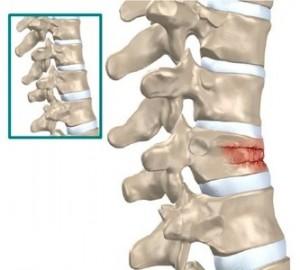 As you get older, your bone density may have decreased putting you at risk for a vertebral compression fracture, or VCF. It is one of the most common fractures that can occur if you have osteoporosis or even low bone mass. Read on to learn how to avoid a vertebral compression fracture.
As you get older, your bone density may have decreased putting you at risk for a vertebral compression fracture, or VCF. It is one of the most common fractures that can occur if you have osteoporosis or even low bone mass. Read on to learn how to avoid a vertebral compression fracture.
Are You At Risk For Vertebral Compression Fracture?
Getting older doesn’t have to mean broken bones – it all depends on the old principle, “move it or lose it”. Your musculoskeletal system was designed for frequent movement. However nowadays, modern technological advances and gadgets do much of the physical work for us, leaving us sitting in front of a computer, on our I-phone, or driving in the car. After working long hours, you may not feel like going to the gym a few days a week. You crash on the couch in front of the television and get even less movement in your day. The upshot is your bones and muscles get weaker and weaker. Pretty soon, with a more sedentary lifestyle, and mid-life hormone changes, your bones can weaken even further – you’re now at increased risk for a vertebral compression fracture (VCF).
What Is a Vertebral Compression Fracture?
A vertebral compression fracture is one that occurs in your spine when your vertebral body, or the bony block, collapses. It is one of the most common fractures in people who have osteoporosis. Yet, it can occur in people who even have moderately decreased bone density. It’s more common in menopausal women but also occurs in older men, affecting about 750,000 people annually.
A VCF usually occurs in your thoracic spine – the upper/middle part of your back – and can cause severe pain, loss of height, and even nerve compression. In younger people with healthy bone density, VCF fractures most commonly occur from an accidental fall, or being in a car accident where you’re hit from behind, or from force exerted on the body while playing sports.
Older people who have moderately decreased bone density can suffer a vertebral compression fracture just doing simple every day activities like lifting a heavier box, or experiencing increased force against their body, or an accidental fall, especially on outstretched hands. In people with osteoporosis, they are at higher risk of a VCF from even lighter activities. In addition, another cause of VCF could be from a metastatic cancerous tumor.
Symptoms of a VCF include:
- Sudden onset of upper/middle back pain that increases when standing or walking and decreases when lying down.
- Limited spinal mobility and/or numbness.
- Diagnosis is done with an x-ray, MRI, or CAT scan.
- A DEXA scan (bone density) will likely also be done to assess bone strength
Treatment includes:
- Surgical if the fracture is compressing a nerve or pushing into tissue
- Non-surgical with back bracing, taping, pain and anti-inflammatory medications
- Treatment with osteoporotic medicines like Boniva, Fosamax, Forte, Actonel, etc.
How To Prevent a Vertebral Compression Fracture
The following are some very good proactive measures you can take to build bone density. They can help prevent a VCF, and other fractures, from limiting your lifestyle.
1. Optimal Bones Diet. Eat a nutritious, vitamin K, Vitamin D, calcium rich diet. Most Americans are deficient in Vitamin D, a crucial bone-density vitamin. Your doctor can check your levels with a simple blood test. Take 1-2,000 IU Vitamin D3 per day. Limit/omit phosphorus containing sodas which leach calcium out of bones and weaken them.
2. Weight Bearing Exercise. Believe it or not, exercise can not only up your energy level at the end of a long day, but it can help insure that you won’t suffer a vertebral compression fracture. The best weight bearing exercises are jumping rope, jumping on a mini-trampoline, walking, running, weight training.
3. Fracture Proof Your House. Check your house for uneven floor surfaces, obstructions in your path like cords, rugs not secured, books, anything you can trip and fall on. Install grab bars in your shower. These are most commonly how VCF’s, wrist, and hip fractures occur.
4. Hormone Replacement. If you’re a man or woman with osteoporosis, or even just decreased bone density, ask your doctor about bioidentical hormone replacement therapy.
If you have any of the symptoms of a VCF, please seek medical help immediately. Remember though, getting older doesn’t have to mean fractures. Taking a little time every day to help ensure your bone density stays strong, through diet and exercise, can mean all the difference between living an active lifestyle or sitting it out on the sidelines.
Stay Well,
Mark Bromson, M.D.
Natural Health News
Vertebral Compression Fracture, http://www.aans.org/Patient%20Information/Conditions%20and%20Treatments/Vertebral%20Compression%20Fractures.aspx
Preventing Spinal Fractures, Diet, Exercise and Physical Exams, http://www.spine-health.com/treatment/back-surgery/preventing-spinal-fractures-diet-exercise-and-physical-exams
image credit: biomed.brown.edu
